Coconut Tree
- November 16, 2023
- 0 comment
The coconut tree, scientifically known as Cocos nucifera, is a versatile and iconic member of the palm family that is not only aesthetically pleasing with its tall, slender trunk and graceful fronds but also serves as a vital resource for many tropical regions.
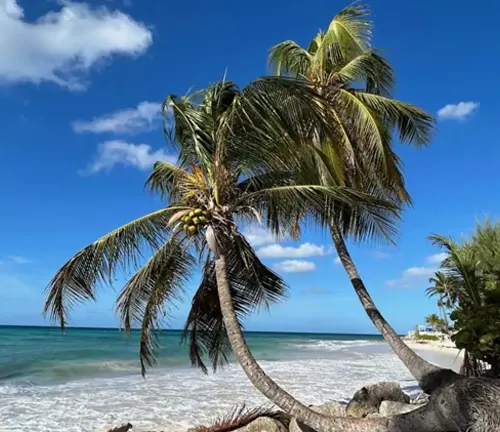
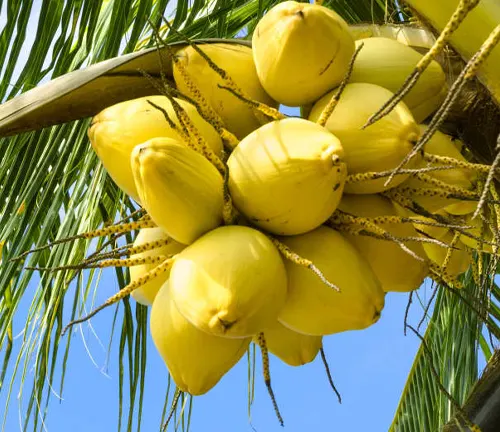
Native to the coastal areas of Southeast Asia, the coconut tree has spread across the globe and is now found in tropical climates worldwide. Renowned as the “tree of life” for its multitude of uses, every part of the coconut tree has practical applications. The towering trunk provides durable timber, the leaves are woven into thatch for shelter, and the fibrous husk surrounding the coconut seed is utilized for making ropes and mats.
However, it is the coconut fruit itself that takes center stage in the culinary world. From refreshing coconut water, rich coconut milk, and versatile coconut oil to the sweet and chewy coconut flesh, this tree yields a bounty of edible delights. Beyond its economic and culinary significance, the coconut tree plays a crucial role in coastal ecosystems, offering protection against erosion and serving as a habitat for various species. The coconut tree stands as a testament to nature’s ingenuity, providing sustenance, livelihoods, and ecological balance to the regions it graces.
| Characteristics | Description |
| Family | Arecaceae |
| Common Name | Coconut Tree |
| Native to | Southeast Asia |
| Geographic Range | Tropical regions worldwide |
| Height | Up to 30 meters (98 feet) |
| Trunk | Tall, slender with a smooth surface |
| Leaves | Pinnate, feathery fronds |
| Uses | Timber, thatch, ropes, mats, coconut water, coconut milk, coconut oil, and edible coconut flesh |
| Economic Significance | Valued for various commercial products and livelihoods |
| Ecological Role | Erosion prevention, habitat for wildlife |
| Symbolic Significance | Often referred to as the “tree of life” |
| Cultural Importance | Plays a role in the traditions and economies of many tropical cultures |
Botanical Beauty of the Coconut Tree
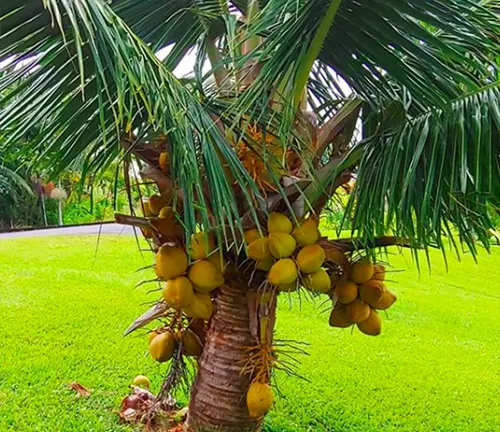
The botanical beauty of the Coconut Tree, scientifically known as Cocos nucifera, is a testament to nature’s artistry. With its tall and slender trunk crowned by feathery fronds, this iconic member of the palm family graces tropical landscapes with its elegant silhouette. The smooth surface of its trunk and the lush greenery of its leaves create a picture of serenity against the backdrop of sun-soaked skies. As a symbol of tropical allure, the coconut tree captures the imagination with its botanical grace, making it a beloved presence in coastal regions worldwide.
Woodland Elegance
Beyond its aesthetic appeal, the Coconut Tree exhibits woodland elegance through the quality of its timber. The tall trunk, straight and strong, provides a valuable source of wood for various purposes. From construction materials to crafting traditional tools, the timber of the coconut tree embodies resilience and versatility. Its contribution to local economies as a source of durable wood underscores its significance beyond its visual allure, connecting communities with the natural resources of their surroundings.

Ecological Importance
The Coconut Tree goes beyond its role as a picturesque addition to tropical landscapes; it plays a crucial role in maintaining ecological balance. Its extensive root system aids in preventing soil erosion along coastlines, offering a natural barrier against the erosive forces of wind and water. As a habitat for diverse wildlife, the coconut tree fosters biodiversity, creating a microcosm of life within its branches. Its ecological importance extends to coastal ecosystems, where it stands as a guardian against the encroaching tides.
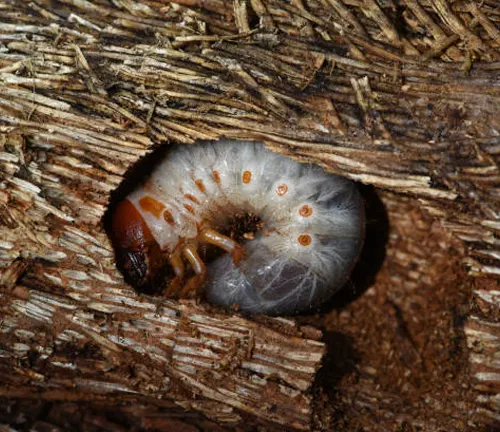
Cultivation and Conservation
Cultivating and conserving the Coconut Tree is not just an agricultural endeavor; it’s a commitment to sustainable practices. With a preference for sandy soils and a demand for ample sunlight and rainfall, coconut cultivation requires a delicate balance. Sustainable agricultural methods ensure the health and longevity of coconut groves, fostering an environment where these trees can thrive. Conservation efforts are integral to preserving the genetic diversity of coconut varieties, ensuring the resilience of this vital tree in the face of changing climates and emerging threats.
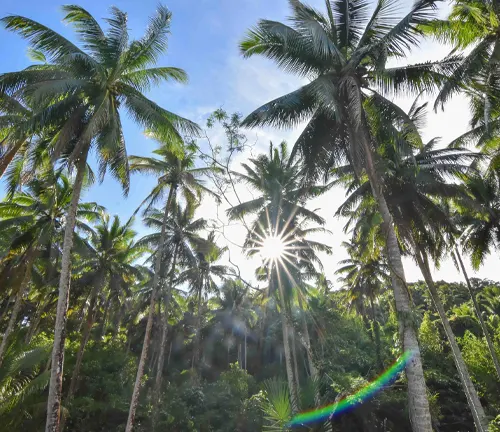
Fragrance
The fragrance of the Coconut Tree is a sensory delight that adds to its allure. The sweet and distinct aroma of coconut infuses the air, creating a tropical ambiance that is both relaxing and invigorating. Whether carried by the breeze from a swaying palm or emanating from freshly harvested coconuts, the fragrance of the coconut tree is a reminder of the sensory richness that nature provides.
Soil Stabilization
One of the unsung heroes of the Coconut Tree is its role in soil stabilization. The extensive root system acts as a natural anchor, preventing soil erosion in coastal areas. This not only protects the land from degradation but also contributes to the formation of stable ecosystems along coastlines. The coconut tree, with its deep-reaching roots, becomes a guardian of the shorelines, ensuring the resilience of coastal habitats.
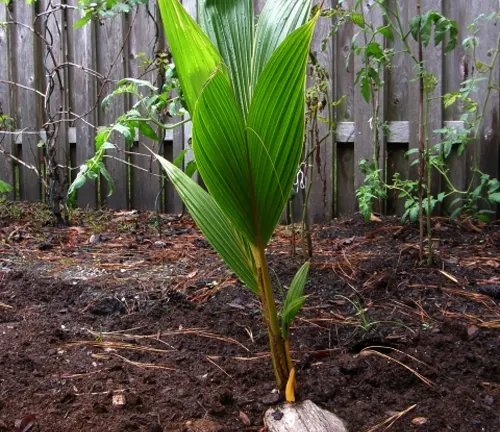
Common Uses
The Coconut Tree is a treasure trove of utility, with every part serving a practical purpose. The leaves are woven into thatch for shelter, the husk is transformed into ropes and mats, and the trunk provides durable timber. However, it is the coconut fruit itself that steals the spotlight. From refreshing coconut water to creamy coconut milk, versatile coconut oil, and delectable flesh, the coconut offers a plethora of culinary delights. Its common uses span traditional craftsmanship to modern gastronomy, reflecting the tree’s adaptability to diverse human needs.
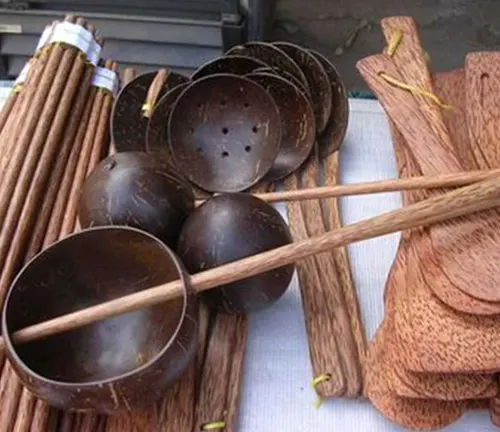
Benefits
The benefits of the Coconut Tree extend far beyond its aesthetic and practical contributions. Economically, it serves as a source of livelihood for communities engaged in coconut cultivation and the production of coconut-based products. Nutritionally, coconut-derived products offer a rich source of essential nutrients and contribute to the well-being of those who incorporate them into their diets. From the environmental benefits of soil stabilization to the cultural significance embedded in traditions, the Coconut Tree stands as a symbol of sustainability and resilience, embodying the harmony between nature and human existence.
Different Species
Tall Variety
(Typica)
This is the traditional and most common variety of coconut tree. It has a tall and straight trunk, with large fronds and a high yield of coconuts. Tall varieties are often grown in tropical regions for their copious fruit production.
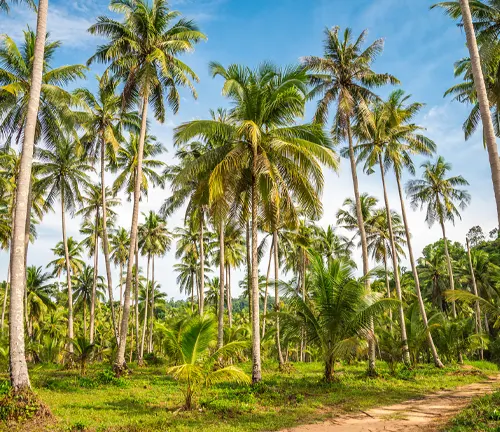
Dwarf Variety
As the name suggests, dwarf coconut trees are smaller in stature compared to tall varieties. They are known for their compact size and are favored in smaller spaces or for home gardens. Despite their smaller size, they produce a considerable number of coconuts.

King Coconut
(Cocos nucifera var. aurantiaca)
This variety is native to Sri Lanka and is distinct for its bright orange or yellow-colored coconut fruits. King coconuts are often consumed for their refreshing water, and the fruit is considered to have a slightly sweeter taste compared to the common green coconuts.
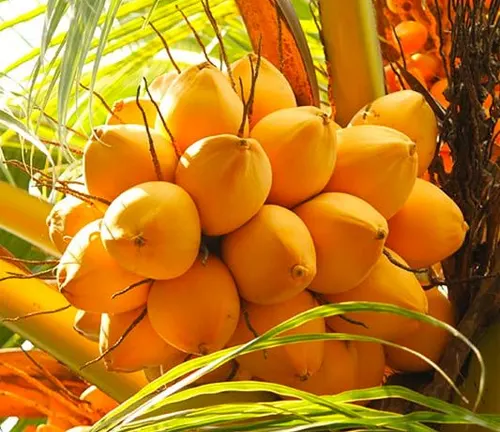
Red Spicata
Also known as the “Red Malayan Dwarf” or “Maypan,” this variety is recognized for its red or pinkish fronds. It is a hybrid between the Malayan Dwarf and the Panama Tall varieties. Red Spicata coconut trees are cultivated for their ornamental value and are sometimes used in landscaping.
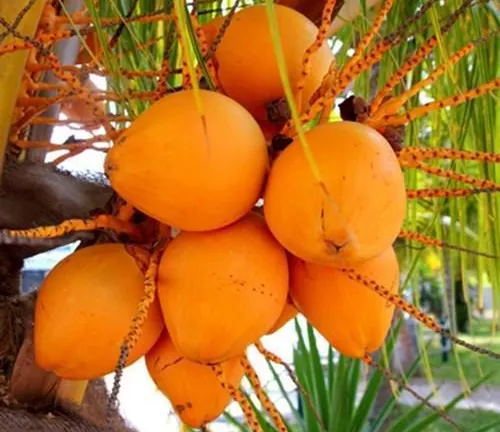
Green Malayan Dwarf
(Cocos nucifera var. Green Malayan)
This is a dwarf variety with a compact size, making it suitable for smaller spaces. It produces medium-sized coconuts and is known for its resistance to certain diseases.
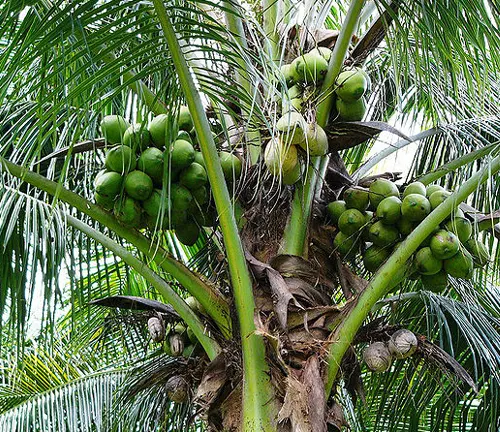
Niu Leka
Native to the Pacific region, particularly Fiji, Niu Leka is a variety of coconut tree known for its decorative appeal. It is often grown for landscaping purposes and is characterized by its slender trunk and arching fronds.
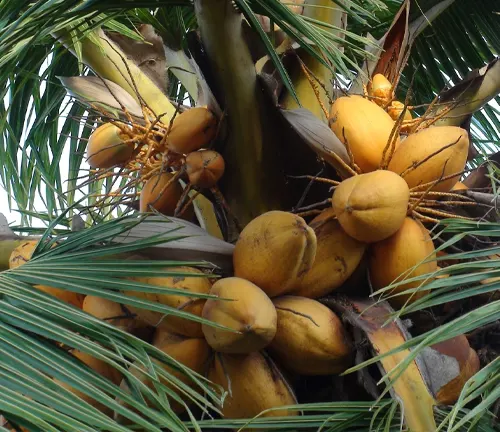
Frequently Asked Questions (FAQs)
- What is the scientific name of the coconut tree?
The scientific name of the coconut tree is Cocos nucifera. - Where are coconut trees found?
Coconut trees are primarily found in tropical regions around the world, especially in Southeast Asia, India, Pacific islands, and parts of the Caribbean. - What are the main parts of the coconut tree that are utilized?
Various parts of the coconut tree are used, including the trunk for timber, leaves for thatch and weaving, husk for ropes and mats, and the coconut fruit for its water, milk, oil, and flesh. - How tall can coconut trees grow?
Coconut trees can grow up to 30 meters (98 feet) in height. - What are the different varieties of coconut trees?
There are several varieties, including tall varieties (Typica), dwarf varieties, King Coconut, Red Spicata, Green Malayan Dwarf, and regional varieties like Niu Leka. - How long does it take for a coconut tree to start bearing fruit?
Generally, coconut trees start producing fruit after 5-6 years, with full production achieved between 10-20 years. - How are coconut trees cultivated?
Coconut trees are typically grown from coconut seeds. They thrive in tropical climates with well-drained soil and regular rainfall. Planting is often done in coastal areas. - Are there any environmental benefits of coconut trees?
Yes, coconut trees play a crucial role in preventing soil erosion in coastal areas due to their extensive root systems. They contribute to soil stabilization and provide habitats for diverse wildlife. - What is the nutritional value of coconut products?
Coconut products such as coconut water, coconut milk, and coconut oil offer various nutrients, including electrolytes, healthy fats, and vitamins. - How is coconut oil extracted?
Coconut oil is extracted from the kernel or meat of mature coconuts through processes like cold-pressing or expeller pressing. - Can coconut trees withstand strong winds and storms?
Coconut trees are known for their flexibility, and while they can withstand moderate winds, severe storms can damage or uproot them. - What is the significance of the coconut tree in cultures and traditions?
The coconut tree holds cultural importance in many tropical regions, symbolizing life, sustenance, and prosperity. It is often used in rituals, ceremonies, and traditional practices.


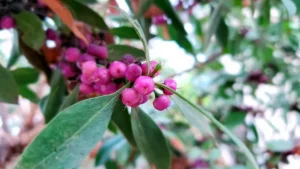
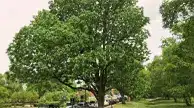

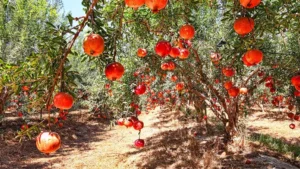
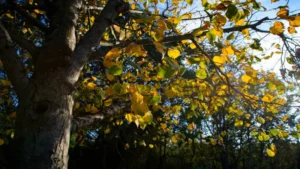


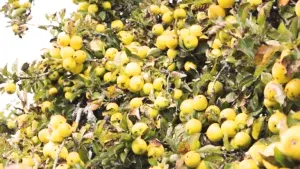
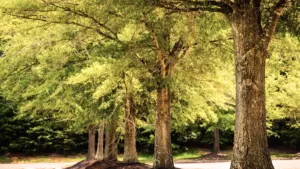
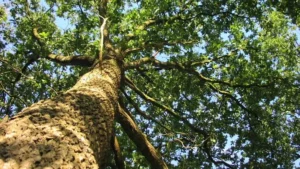


Leave your comment